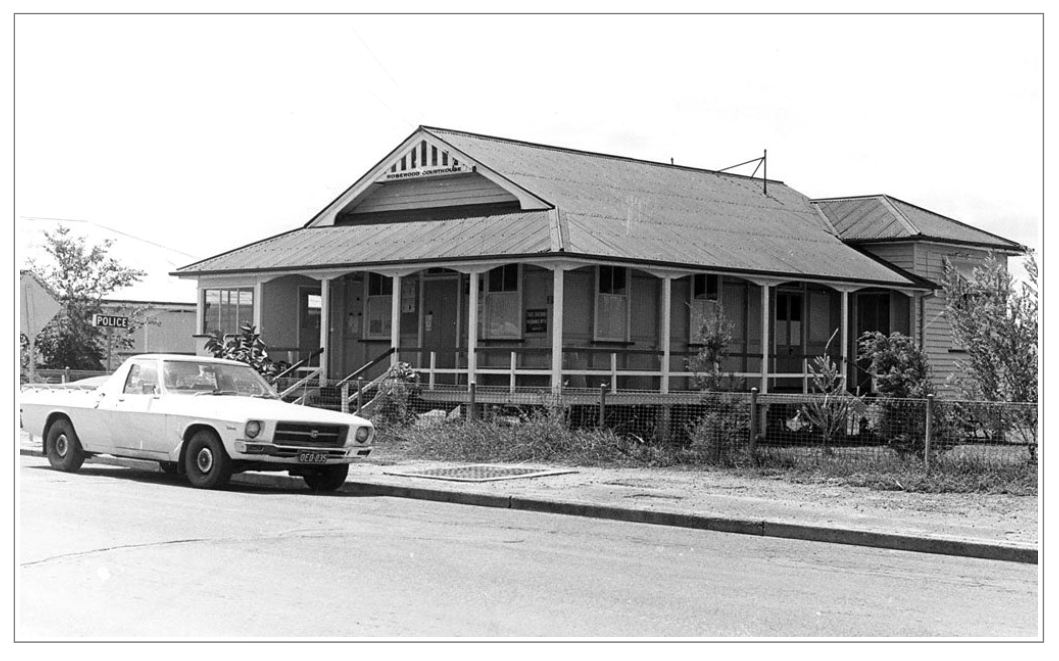
Rosewood Police Station 1981 (formerly the Courthouse)
Photo: Courtesy of Kathryn Rodgers Source: Picture Ipswich
Rosewood History
The Rosewood Police Precinct
A public meeting was held in the school house at Rosewood Gate on Saturday evening, the 21st October 1876, for the purpose of petitioning the Government for police protection. It was resolved that Messrs Jack Dudley Moore, John William Vance and Dan Desbois would prepare the petition, which was left at the Post Office for signatures and then forwarded to the head of the Police Department.
By November that year it was announced that police barracks would be built at Rosewood Gate instead of locating them at Walloon. It was felt that Rosewood Gate was more central between Ipswich and Laidley and had more roads joining to it.
It was another year before some progress was made. The police authorities bought Mr Jackson’s property, opposite the original railway station, for the site of the barracks. It was thought to be an excellent site, and with some alterations, would be well suited for the purpose.
In February 1878 the Department of Public Works called for tenders for repairs and additions to the Rosewood Police Station.
When the news spread through the district that a new station was going to be built, the residents of Walloon felt that it was unfair to deprive them of police protection there. They held a public meeting at their school house to protest. They had raised enough money to meet the required quota to build a school and teacher’s residence there. The school house had been built but the residence had not. The police lock up was converted to a residence instead, and the policeman was being shifted to Rosewood. They had come to the unhappy conclusion that the remainder of their money was going to be put towards buying the land and premises at Rosewood for the barracks. Mr J. M. Thompson, M. L. A, complained to the Colonial Secretary on the Walloon residents’ behalf. He was told that the matter had gone too far and it was too late to change the arrangements. As for the money being held by the Education Department being applied to the Rosewood lockup, he told Mr Thompson to take it up with the Department.
The Secretary of Lands said that the land for the police station including improvements, two timber buildings and a paling fence enclosing it would cost £350. The buildings, alterations, and additions would cost £100. Ultimately the barracks were built by August 1878. Constable Gordon Kirkpatrick, previously stationed at Walloon, was in charge until he left the next month.
Court was held in the single constable’s room in the police barracks (station), which was on the corner of John Street and Railway Street (back then Walloon Road).
Tenders were called for a new detached courtroom to be built in November 1892. The tender of my great grandfather, James Campbell Thomson, of £93 14s., (time two months) was accepted by the Works Department. The courtroom was built next to the police station, both facing Railway Street.
In 1905 and 1906 there was much discussion about the inadequacy of the accommodation at the Rosewood Courthouse, as to floor space and furniture and its “antediluvian arrangements” (belonging to the time before the biblical flood). It was thought to be a disgraceful state of affairs. The size of the building would make it difficult to “swing a cat” in it. There weren’t sufficient chairs to seat six people, some of which had no seats. The sitter had to be supplied with books or anything handy to make it work. The sergeant brought chairs from his own house for court sittings. The water tank leaked in several places and was plugged up with corks and rags, and the toilet arrangements were badly in need of attention.
There were eight justices on the Bench, and as accommodation is provided for only four or five, the remainder had to put up with seats on the floor of the building. As for the general public, seats were provided for 12 or 14 persons only, and if there should be more than that number they have to go outside, which is not very pleasant, especially in warm weather, seeing that the building has no verandahs. (1)
Once the decision was made to replace the building it caused some controversy amongst the townsfolk as to whether or not the police barracks should be moved elsewhere. A deputation consisting of Messrs. Dutney, Rea, Stevens (President of the Farmer’s Club), Pender, and Hodge (Shire Council) went to see Mr. Thomas Sullivan, the Minister for Public Works, about having the police barracks moved. They argued that the site was one of the most valuable sites in the town and that all of the business carried on there was under the direct notice of the general public. They proposed that the land etc should be sold and a portion of the school reserve resumed for the purpose.
The school committee objected to that proposal. Saturday 27 January 1906 – On Wednesday evening a meeting of parents of scholars attending the Rosewood State School was held in the school-room to protest against part of the school grounds being used for the new police station. The meeting, which was very poorly attended, was presided over by the chairman of the committee. The school-ground comprises something like 10 acres of land, and it was proposed to alienate one acre for erecting a new police station, which would be surrounded by a 7ft galvanised iron fence, thereby preventing any interference with the school. After due. discussion it was decided, that a protest should be made against the alienation of any portion of the school-grounds. The present police buildings occupy a corner site in the township, which is eminently suited for a place of business. It in understood that the authorities intend to sell this block as soon as a suitable piece of land can be obtained for the new police station. This latter is very badly needed, and there should be no difficulty in obtaining the necessary site, as there are several pieces of land available.
The Minister for Works ultimately decided that the courthouse would be erected on the old site.
With regard to the above Mr. D. T. Keogh, M.L.A., has received the following communication: Department of Public Works, Brisbane, 9th March1906. Sir, Referring to your interview with the Minister, today, on the subject of the erection of a new Court House and police station at Rosewood, I have the honour, by direction, to inform you that the question as to the most suitable site for such buildings having been settled, the erection of same would be at once proceeded with but for the fact that funds are not available for the purpose. The question of proceeding with the work will, however, receive favourable consideration early next financial year. I have the honour to be, sir, your obedient servant, A. B. BRADY, Under-Secretary and Government Architect. (1)
In November 1906 tenders were called for a new court-house and police barracks. In February 1907 the tender of local contractor Charles Ridsdale to build the double-cell buildings and stables was accepted, the contract price being £791 15s. Bartholomew Coveney purchased the old police building, courthouse and tanks for £34 and removed them.
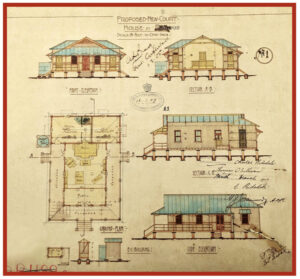
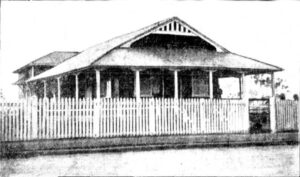
Mr. D. T. Keogh, the member for Rosewood, received the following communication:- Department of Justice Brisbane, September 12. The Clerk of Petty Sessions at Rosewood has been instructed to take over the Court House, Rosewood; and, on behalf the Attorney General, I congratulate the residents of the district on the event, and hope justice will be administered wisely in the new building. Yours, &c. J. B. HALL.
The new Courthouse, which fronted John Street, was opened on 23rd September 1907. The new residence was built on the site of the old barracks, fronting Railway Street.

A crowd of spectators assembled and walked through the gate (pictured) to listen to the first proceedings held there. Five young men, Peter Brennan, Peter Cummins, Frank Heap, John Cannon, and John Ahearn, were brought before the Police Magistrate and Messrs E. Collins, G. H. Dutney, P. J. O’Donahue, and P. H. Adams to answer to a charge of having done grievous bodily harm to Frederick Stiff. Cannon and Ahearn were discharged and the others were committed for trial in the Ipswich Court.
 It may be mentioned that the edifice is a very much superior building to the old “temple of justice.” It is much more commodious, and is admirably lighted and well ventilated. On each side of the main entrance door over which is a in-light, there is a large window. In each side wall are two large windows and French-light doors, with a fan-light above the latter. For the convenience of solicitors a couple of tables are provided. The dock and witness-box are portable and may, therefore, be placed in the most convenient position. The witness-box is certainly a great improvement on that in the Ipswich and some other Court-houses. It is provided with a seat, upon which the witnesses are allowed to sit whilst they are giving evidence, and immediately in front in a shelf. Those who attended the Court yesterday appreciated the conveniences provided in the new building. (2)
It may be mentioned that the edifice is a very much superior building to the old “temple of justice.” It is much more commodious, and is admirably lighted and well ventilated. On each side of the main entrance door over which is a in-light, there is a large window. In each side wall are two large windows and French-light doors, with a fan-light above the latter. For the convenience of solicitors a couple of tables are provided. The dock and witness-box are portable and may, therefore, be placed in the most convenient position. The witness-box is certainly a great improvement on that in the Ipswich and some other Court-houses. It is provided with a seat, upon which the witnesses are allowed to sit whilst they are giving evidence, and immediately in front in a shelf. Those who attended the Court yesterday appreciated the conveniences provided in the new building. (2)
The Police occupied the two offices in the rear section of the new Court House until 1916 when Mr. D. J. Kay from Toowoomba was appointed Clerk of Petty Sessions for Rosewood. Previously police Sergeant Allen had carried out these duties, but owing to the large amount of clerical work, a permanent C.P.S. was installed. Mr. Kay now occupied one office and the police occupied the other office. He was replaced by Mr. W. E. McKenna in 1918.
Early in 1910, the Rosewood residents were expressing a great deal of indignation at the intention to fence in the reserve on the flat to serve as a police paddock. Part of the land was always used as a recreation ground, and through it, a means of getting to and from the township was accessed by means of the subway under Moran’s Bridge. The Shire Council, assisted by the Government had stoned it and made it passable for traffic, therefore assisting the townsfolk in being delayed at the railway gates because of the railway traffic. Active measures were taken to prevent what many people considered would be an injustice to the public. This area was the only Government land in the vicinity of the township at the time.
In May 1924 an addition was made to the police station residence when a side verandah was added. This was enclosed in 1939.
Probably the most famous case heard in the courthouse was the trial of Alan Christopher Jeynes who was accused of the murder of 18 year old Louisa Caroline Bade at Ebenezer in June 1926. Jeynes was found guilty and sentenced to life imprisonment with hard labour.
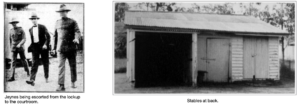
During the late 1940s, the court house was also used as additional sleeping accommodation for constables attached to the police station.
The police station and residence were painted in March 1950 by employees of the the Public Works Department in readiness for Sergeant W. Zillman and his family to take up residence. The police horses were still being stabled at the back of the station.
By the late 1960s, the facilities provided for the police were once again inadequate, having only one office, no public counter and limited storage space.
A brick building was constructed at the back of the courthouse around 1970 for toilet facilities.
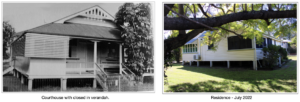
The northern verandah of the court house was enclosed in 1977 by local man Spencer Yarrow, to provide the police with additional office space.
By 1986, there was again insufficient space to accommodate the police, and a new police station was constructed in 1987.
The lock-up, which was located behind the courthouse, was moved to the old BMX ground in 1987 (near Anzac Park). It was used as a canteen before the track closed in the early 1990’s. In the early hours of the morning on 12th August 2015, it was moved back to John Street to a new site at Cobb & Co Heritage Park.

If you notice the lockup doesn’t have the landing and steps on the end. At this stage they were on the front towards the house. I enclosed the verandah late 70s and changed the steps on the lockup around 1980-81. – Spencer Yarrow
The Rosewood Courthouse was closed in 1991 and has since been used for other purposes. On the 6th June 1994, the Rosewood Police Complex was listed on the Queensland Heritage Register.
As of Monday 16th October 2023, the Rosewood Police Station was closed and the Officers were moved to Marburg Station temporarily while a new police station was built. Demolition work began on 11th December. The police station, which stood between the old courthouse (now PRD Real Estate) and the old police residence, was demolished and the residence was moved from its corner position back next to the old Courthouse in its place. Moving the historic residence allowed the new station to be built on the corner of John Street and Railway Street.
The new Rosewood Police Station opened for business on Monday, 16th September 2024. It was officially opened Thursday, 26th by the Honourable Mark Ryan MP (Minister for Police and Community Safety) and Acting Commissioner Shane Chelepy APM (Queensland Police Service).

The Rosewood Police Precinct before the new Police Station was built.
L-R: The old Courthouse, then the Police Station (demolished) fronting John Street. On the corner is the old residence which fronted Railway Street (No 13)
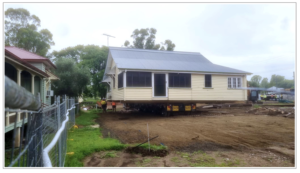
Moving the old residence up beside the Courthouse. (22nd January 2024)

The Rosewood Police Precinct after the new Police Station was built, 20th September 2024.

The Rosewood Police Precinct looking north, showing the new Police Station and repositioned residence next to the former Courthouse.
The front and side verandahs of the residence have been been opened up to match the style of the old Courthouse.
© Jane Schy, 2024
Sources:
(1) Queensland Times, Ipswich Herald and General Advertiser, Saturday, 17 March 1906, page 4
(2) Queensland Times, Ipswich Herald and General Advertiser, Tuesday, 24 September, 1907, page 11
Queensland State Archives
Trove National Library Australia
